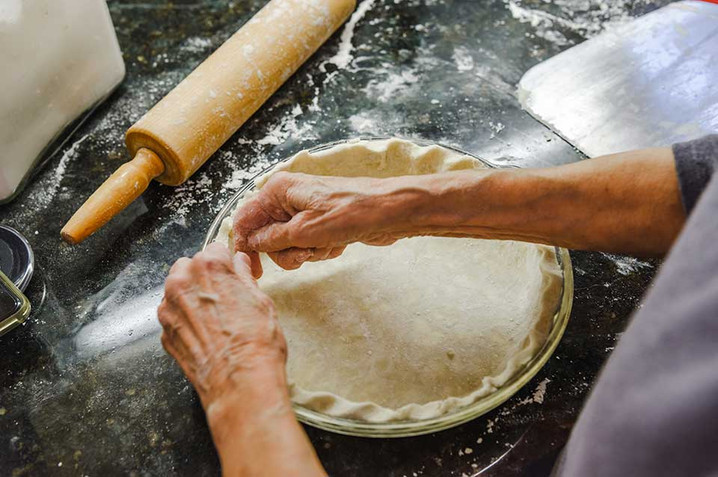30th Jul 2015
4 Steps to a Perfect Pie Crust
Baking a flaky, buttery pie crust is the ultimate, elusive skill. In the old days most communities would have contests for the best pies, and you would have really won an honor if you carried off first prize on that one. They had contests for tatting the prettiest lace, pickling the best pickles, growing the fattest pig, and baking beautiful bread, but for the women none of them held the prestige baking a perfect pie afforded. Considering the fact that they dealt with unreliable heat sources and less fool-proof ingredients than we use today - this was a skill indeed.
It’s not a skill learned overnight, unless you are one of those lucky people that try succeed at everything naturally. The flip side is that understanding what you’re going for with a few tips along can make it reachable for even beginner bakers. Pie crust doesn’t have to be difficult, but there are a couple of things to practice to take the tough out of the crust.
Avoiding the Tough Crust
Any seasoned baker (or eater!) will tell you that if the crust on the pie is no good the rest of the pie isn’t going to be spectacular. Pie crusts aren’t meant to chewy and tough but rather flaky and buttery. There’s quite a few things that go into a tender crust, starting with the most important thing you don’t want to have happen.
Flour naturally contains gluten, a protein that develops a structure when worked overly much. In bread this is a wonderful thing when used with yeast because the gluten will be the structure that holds the light, fluffiness of the dough, but in pie crusts this is the last thing you want to have happen. The best way to solve this is to work the pastry as little as possible. You’ll want to mix the wet ingredients into the pastry dough until just barely mixed.
Unless you are an experienced baker add an acid to the crust such as vinegar or lemon. A tablespoon will do to works wonders to to inhibit the gluten from working the dough and keep it tender and flaky. This can be added when you add wet ingredients such as egg or water.
Warm or Cold Ingredients
Crust ingredients should be kept as chill as possible, especially with the ingredients of butter and water. Butter should be still cold enough to slice into chunks, and water icy while still being mixable. It will be ok to see flakes of butter or egg, if you used an egg as this will add to the general softness and flakiness of the crust. The egg isn’t very important, though some prefer it to soften the dough and add to the taste.
Rolling It
This part can also be tricky, because if the dough doesn’t have enough flour or too much it will either stick to your surface or not hold together well. A couple of things can help with this. First go with the tip above to get a dough that is neither sticky nor dry. Then, lightly flour your surface of choice to keep the dough from rolling “into” the spot, flipping it once or twice if necessary with a bit more flour.
If it still sticks roll the dough out between two pieces of parchment paper, lift/peel on side and gently lay into pie pan. Otherwise you’ll lift from the surface and transfer to the pie pan hoping it will stay in one piece. Once you’ve gained more experience doing it without the paper becomes easier as you learn what the best pie crust dough feels like.
Baking
Some say pie crusts are easier baked in heat-resistant glass pie plates, though it is mostly a matter of knowing your oven and having a good quality pan. Also, locate the hottest area in your oven and place as far away as possible from there. If it comes from the top, place in bottom half or vice versa. Generally pies are baked beginning at 425° for 10 minutes before temperature is reduced to 350° and baked for however long filling requires. This may change from recipe to recipe.
Kauffman’s Fresh Peach Pie
Pie Crust Ingredients:
This recipe makes more than (4) pie crusts, however the extra freezes well for whenever you may need an extra pre-rolled crust, or it can be frozen in rounds and thawed and rolled at any time.
Ingredients:
4 cups flour
2 tablespoons sugar
1 tablespoon salt
1 3/4 cups shortening or lard
1 egg
1 tablespoon vinegar
1/2 cup plus 2 tablespoons ice cold water
Instructions:
- Combine all the dry ingredients in a large bowl. Cut in shortening or lard with a fork or pastry blender until the dough resembles cornmeal; set aside.
- Whisk together egg and vinegar in a small bowl, add the cold water and whisk again. Add small amounts of this liquid mixture slowly to the dough at a time, blending together with a fork until it comes together into a ball.
- Divide dough into 4 balls, flatten whatever you want to use into disks and chill for about an hour before rolling and putting it into the pie pan. Refrigerate or freeze whatever you didn’t use for later use.
Fresh Peach Filling
Ingredients:
¾ cup sugar
½ tsp. salt
1 rounded T. Clearjel (cornstarch may be used to substitute)
1 cup water
½ cup peach or orange gelatin
Fresh sliced peaches (about 5 medium peaches)
9” baked pie shell
Instructions:
Mix together sugar, salt and clearjel. Stir in water. Cook until thickened and clear.
Remove from heat; stir in gelatin. Cool. Mix in sliced peaches and spread into crust. Chill for several hours.
Just before eating top with whipped cream. Slice. Enjoy.

